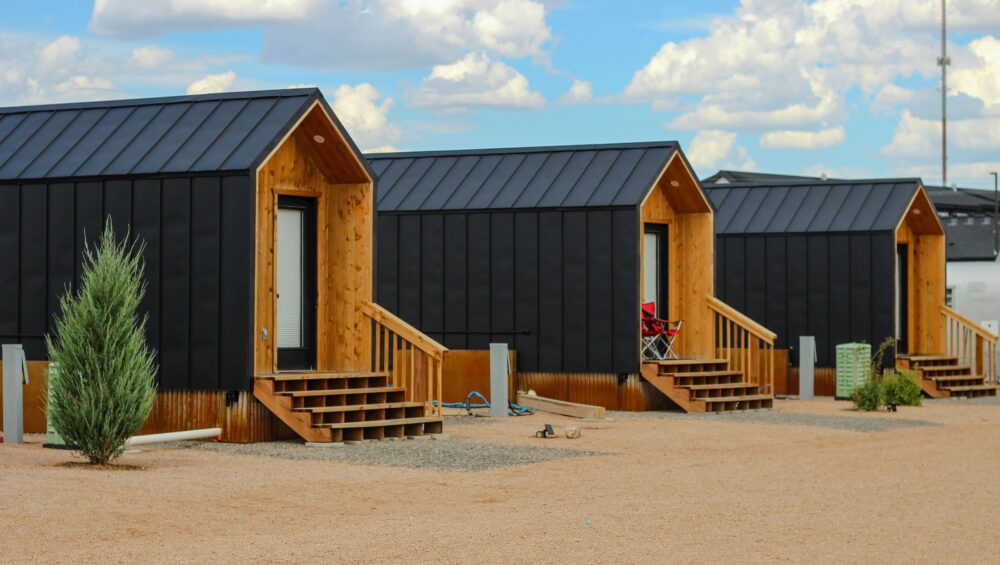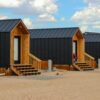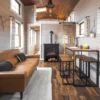
Backyard tiny Home Rentals can be Income Generators
Your tiny home can be a reflection of your unique lifestyle and preferences.
Choose a theme: Whether it’s minimalist, rustic, or modern, select a theme that resonates with your personality to guide your design choices.
Embrace sustainability: Consider using eco-friendly materials and energy-efficient appliances to minimize your environmental impact.
Consider smart storage solutions: Use built-in shelves and furniture with hidden compartments to maintain a clean and organized look.
Here are some tips to customize your space:
1.
Personalize with textiles: Incorporate rugs, curtains, and cushions that reflect your style while adding warmth and comfort to your space.
Experiment with lighting: Utilize different types of lighting to create ambiance and enhance the visual appeal of your home.
Include a workspace: Designate an area with a desk or table where you can focus on tasks or hobbies while enjoying your tiny home.
Personalize the layout: Reconfigure the floor plan to suit your daily routines and activities.
Focus on ergonomics: Select furniture that not only looks good but also promotes comfort and good posture.
Curate personal touches: Display items that hold sentimental value or represent your journey to make the space uniquely yours.
Introduce color pops: Use accent colors to add vibrancy and life to your home, making it feel more dynamic and inviting.
2.
Use mirrors strategically: To create an illusion of more space and enhance natural light, strategically place mirrors throughout your tiny home.
Incorporate natural elements: Bring the outdoors in by adding plants, which can improve air quality and provide a sense of tranquility.
Think about durability: Choose materials and finishes that can withstand daily use while maintaining their appearance.
Choose versatile furniture: Opt for multi-functional pieces that can adapt to your needs.
Stay organized: Regularly assess and declutter your space to keep it from feeling cramped and to ensure it continues to meet your needs.
Adjust for seasons: Keep your space dynamic by changing decor and layout with the seasons, making it feel fresh and inviting year-round.
Incorporate outdoor living: Extend your living space by creating an outdoor area that can be enjoyed as an extension of your tiny home.
3.
Design with sustainability in mind: Use reclaimed materials where possible and opt for low-waste designs to further enhance your eco-friendly approach.
Connect with nature: Design spaces that offer views of nature or outdoor areas that can be easily accessed.
Use regional inspiration: Incorporate design elements that reflect local culture or natural beauty, connecting your home to its surroundings.
Incorporate your style: Infuse your design aesthetic through colors, materials, and decor.
Create a visual focal point: Designate one area as the centerpiece of your home, such as a striking piece of art or an interesting furniture arrangement.
Utilize wall space: Install shelves and hooks to optimize vertical space for storage and decoration.
Explore various use cases: Assess how you might use each space differently at different times, and design for flexibility to accommodate those changes.
4.
Think about modular solutions: Use modular furniture that can be easily rearranged or expanded based on your changing needs.
Make use of underutilized areas: Explore innovative ways to use corners and nooks to enhance functionality without overcrowding the space.
Prioritize comfort: Ensure that each space within your home feels welcoming and cozy, encouraging you to unwind and relax.
Maximize storage: Get creative with storage solutions to keep your space organized.
Display your hobbies: Showcase your interests, whether it’s books, art supplies, or musical instruments, as part of your home’s design.
Add a touch of personality: Consider integrating unique art pieces that inspire you and reflect your character.
Incorporate ambient sounds: Consider adding sound elements like water features or soft music to enhance your living environment.
5.
Utilize multi-functional spaces: Design rooms or areas that can serve more than one purpose to maximize their utility.
Implement smart technology: Use smart home devices to enhance convenience and efficiency in your tiny home.
Embrace natural light: Use window treatments that allow natural light to flood in while still providing privacy.
Create functional zones: Designate areas for work, relaxation, and hobbies to enhance your living experience..
Regularly revisit your design: As your life evolves, make time to reassess and modify your space to better suit your current needs.
Stay flexible: Ensure your design allows for easy adjustments as your lifestyle and needs evolve.
Create harmony: Ensure that all design elements work together cohesively to create a unified and balanced atmosphere.
.
Celebrate your journey: Let your home be a narrative of your experiences, including travel souvenirs or family heirlooms that resonate with you.






